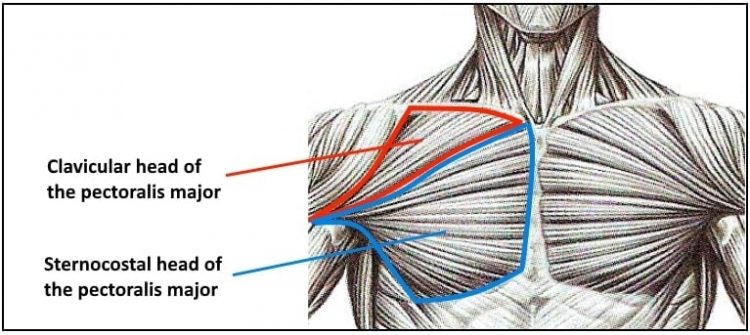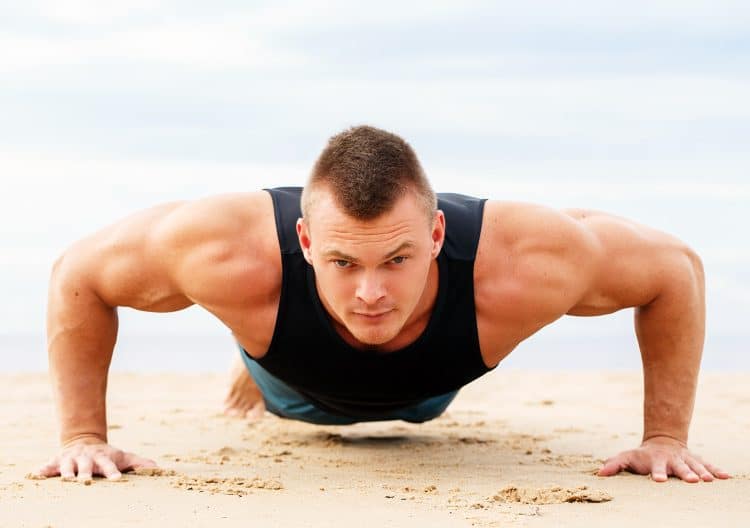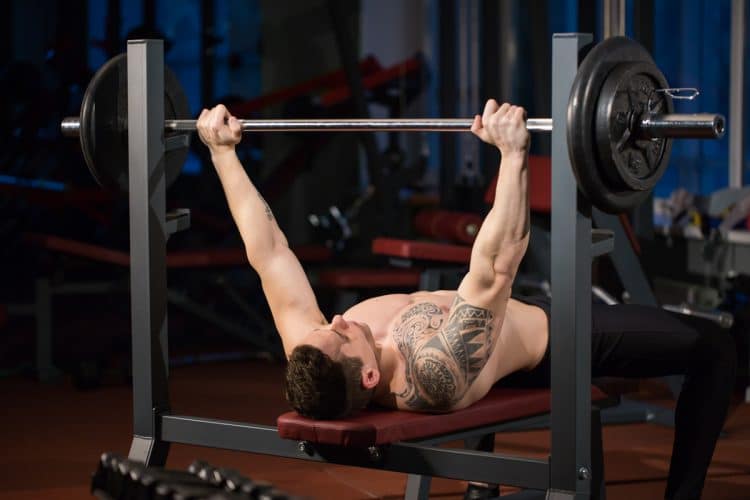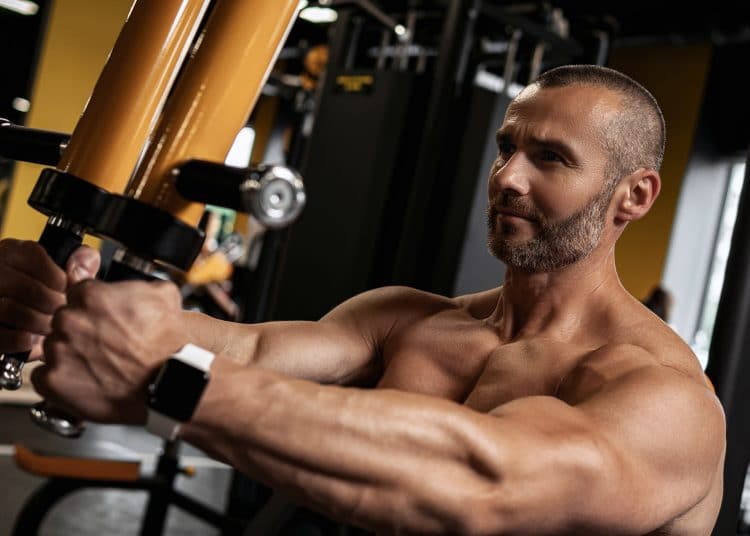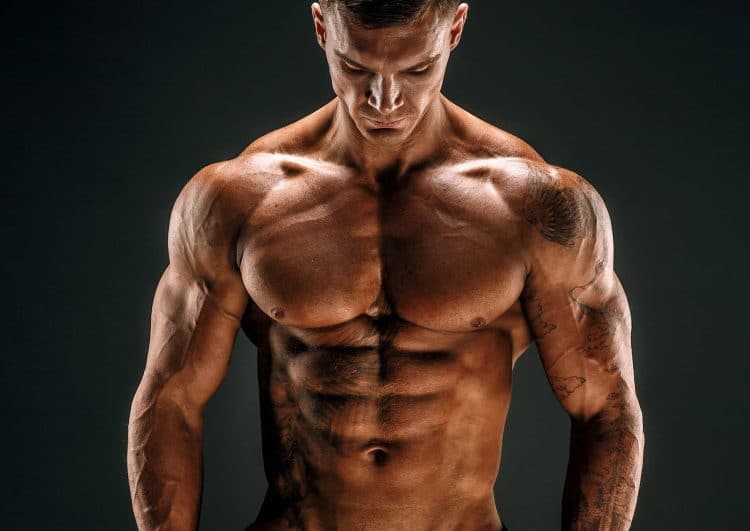Famously, in almost every gym around the world, Monday is National Chest Training Day. Bodybuilders love training their pecs, and, after a restful Sunday, they’re raring to start their week with a chest workout.
Some may justify this by quoting the Joe Weider priority training principle, but, in most cases, it’s just that chest day is so darn satisfying. After all, most pec programs are built around the bench press, and everyone loves that exercise!
So, why is it then that so many bodybuilders are also unsatisfied with their chest development?
Could it be an over-reliance on the bench press? Doing the same exercises every week? Not varying their set and rep scheme? Or only training their chests once per seven days?
All of these “bodybuilding sins” could undermine your pec-building progress.
So, if you are stuck in a training rut, we’re here to help! Try our bodybuilding workout for bigger pecs sculpt a chest to be proud of.
Chest Anatomy for Bigger Pecs
Your chest is made up of two main muscles. Knowing a little about the form and function of these muscles could help you get better results from your workouts.
That said, you don’t need in-depth anatomical knowledge to build bigger pecs, so feel free to skip this section and jump straight to the workouts if you wish. It’s your choice!
Pectoralis major
Known as your pecs for short, this is the largest chest muscle. Its main functions are horizontal flexion, adduction, and medial rotation of your shoulder joint.
While the pecs are a single muscle, they are made up of several groups of fibers, often referred to as heads. All three heads work together, but it’s also possible to emphasize one at a time by adjusting the angle of your arms.
- Clavicular head – this is your upper chest. It’s more active during incline movements, such as incline bench press and incline flyes.
- Sternal head – the most prominent pec head, this region forms the bulk of your chest. It’s most active during flat pec exercises, such as flat bench presses and pec deck.
- Abdominal head – this is your lower chest. Exercises like dips and high-to-low cable crossovers emphasize this region of your pecs.
The clavicular head of the pectoralis major, often just called the upper pecs, is more active during incline chest exercises. Conversely, the sternocostal head, or lower pecs, is more active during decline movements (2). Because of this, you must train your pecs from multiple angles to develop them fully.
Pectoralis minor
Pec minor is a thin, flat muscle that lies underneath the pec major. It assists your pec major during most chest exercises and prevents your shoulders from lifting as you move them. Pec minor does not contribute much to chest size, but it’s still an important muscle.
Bodybuilding Workout for Big Pecs – Overview
Variety, they say, is the spice of life, and that’s especially true for bodybuilding. A lot of bodybuilders are self-sabotaging themselves by doing the same chest workout for months or even years. It usually goes something like this:
- Bench press 3 x 8-12
- Incline dumbbell bench press 3 x 8-12
- Cable crossover 3 x 8-12
- Chest press machine 3 x 8-12
Boring!!!
Studies show that exercise variation can be helpful in increasing workout motivation, not to mention increasing strength (1). And, as every bodybuilder knows, strength increases usually go hand in hand with increased hypertrophy.
Plus, a lot of bodybuilders only train their pecs once a week. This is another mistake. Muscles usually recover and are therefore ready to train 72 hours after your last workout. That means you can train your chest more often and make even better progress.
With all that in mind, our bodybuilding workout for bigger pecs include:
- New and unusual exercises
- A mix of set and rep schemes
- Two chest workouts per week
The fact that this workout is so different from what you’re currently doing is why it’s going to work!
Alternate the following workouts, allowing a couple of days rest between each one to allow for rest and recovery, i.e., Monday and Thursday or Tuesday and Friday. Follow this program for 6-8 weeks and then switch to a new workout to avoid stagnation.
Big Pecs Workout #1
Do this workout at the start of your training week, when your energy and enthusiasm should be at their highest. As always, start each workout with a brief warm-up to prepare your muscles and joints for what’s to come.
Begin with 5-10 minutes of easy cardio followed by dynamic mobility and flexibility exercises for your upper body. Finish your warm-up with 50-100 light band pull-aparts to increase upper-back activation and shoulder stability.
| No: | Exercise | Sets | Reps | Recovery |
| 1 | Incline dumbbell bench press | 4 | 6-8 | 2 minutes |
| 2 | Cable/dumbbell supine press | 3 | 8-10 | 90 seconds |
| 3 | Chest dip | 3 | AMRAP | 90 seconds |
| 4 | Wide grip 1 ½ rep bench press | 2 | 10-12 | 60 seconds |
| 5 | Push-up | 1 | 100 | N/A |
Not sure how to do any of these exercises? No problem! Just follow the instructions below:
1. Incline Dumbbell Bench Press
Most bodybuilders start their chest workout with the barbell bench press. While that CAN work, if you’ve been using the same approach for a while, it’s probably time for a change. So, we’re kicking this workout off with four sets of incline dumbbell bench presses.
Set your bench to between 30-45 degrees and pause at the bottom of each rep for 2-3 seconds. No, you won’t be able to go as heavy by adding pauses. Still, you’re a bodybuilder and not a powerlifter, so that’s not actually important, right?
Read up on how to do incline dumbbell bench presses here.
2. Cable/Dumbbell Supine Press
It’s time to get a little weird with this cable/dumbbell press hybrid. The cables pull your arms outward as you press the dumbbells up, creating an intense full-range muscular contraction. If your pecs are sore tomorrow, this exercise is the culprit.
How to do it:
- Place an exercise bench in the center of a cable crossover machine. Put a cable cuff around each wrist and attach them to the lowermost pulleys. With a dumbbell in each hand, sit and then lie on your bench. Press the weights up to arms’ length over your chest. Use a neutral or pronated grip as preferred.
- Bend your elbows and lower the weights to your shoulders. Press inward to overcome the resistance from the cables.
- Push the weights up and in to return to the starting position.
- Repeat for the desired number of repetitions.
3. Chest Dip
A lot of bodybuilders do dips but don’t pay much attention to their technique. Subsequently, they fail to get meaningful results from what should be a very productive exercise. Chest dips are pretty different from doing dips for bigger, stronger triceps, and, done right, you’ll really feel this exercise in your lower, outer chest.
How to do it:
- Use dipping bars that are wider than shoulder-width apart. The narrower your grip, the less chest engagement there will be.
- Place your hands on the bars with your palms turned inward. Support your weight on straight arms.
- Bend your knees and push your legs and hips as far back as you can. The greater the incline, the more pec activation there will be.
- Bend your arms and descend as far as you can without hurting your shoulders. Get a good stretch in your pecs. Allow your upper arms and elbows to flare outward.
- Extend your elbows and push yourself upward, stopping just short of lockout to keep the tension on your pecs. Push inward as well as downward to maximize pec engagement.
- Descend and repeat.
4. Wide Grip 1 ½ Rep Bench Press
This exercise is all about getting plenty of time under tension and creating a lot of metabolic stress in your pecs. Forget about lifting heavy weights. Instead, disengage your ego and concentrate on your mind-muscle connection. By the end of this exercise, your pecs should be so pumped that it feels like they’re going to burst out of your skin!
How to do it:
- Lie on a flat bench with your eyes directly under the bar. Hold the bar using an overhand grip with your hands roughly 5-8 inches further apart than usual. Brace your core and pull your shoulders down and back.
- Unrack the bar.
- Lower the bar under control to lightly touch your sternum.
- Press the weight about halfway up.
- Lower it back to your chest.
- Press the bar all the way up to arms’ length, stopping just short of locking your elbows.
- That’s one rep – keep going!
5. Push-up
Your final chest exercise in pec workout #1 is the humble push-up. However, after everything that’s gone before, what’s usually a pretty easy exercise will feel a whole lot more challenging. Simply pump out 100 push-ups in as few attempts as possible.
Ideally, you should complete this challenge in under five minutes. Rest when you need to, but keep your breaks short, even if it means you end up doing five reps at a time.
You can remind yourself how to do push-ups here.
Big Pecs Workout #2
Do this workout 3-4 days after workout #1 to allow enough time for recovery. You may still be a little sore, but that’s okay. Just spend an extra couple of minutes warming up.
As before, start your workout with a brief warm-up to prepare your muscles and joints for what’s to come. Begin with 5-10 minutes of easy cardio followed by dynamic mobility and flexibility exercises for your upper body. Finish your warm-up with 50-100 band pull-aparts.
| No: | Exercise | Sets | Reps | Recovery |
| 1 | Bench press | 10 | 3 | EMOM |
| 2a | Incline dumbbell fly | 4 | 10-12 | 60 seconds |
| 2b | Incline dumbbell press | 8-10 | ||
| 3 | Decline bench press | 3 | 8-10 | 90 seconds |
| 4 | Pec deck (with drop sets) | 2 | 12-15 | 60 seconds |
| 5 | Smith machine push-up ladder | 1 | AMRAP | N/A |
Not sure how to do any of these exercises? No problem! Just follow the instructions below:
1. Bench Press
Yay – it’s the bench press! But, before you start celebrating too much, you need to understand that this isn’t your regular bench press workout. Instead, you will do one set of three reps every minute on the minute (EMOM) for ten minutes.
Use about 80% of your 1RM, which is a weight you should be able to lift six times. The first few sets should be pretty easy, but you’ll have to really grind out the last few sets.
Revise your bench press technique here.
2a & 2b Incline Dumbbell Fly/Incline Dumbbell Press
Your next two pec exercises are a superset of incline dumbbell flies and incline dumbbell presses. To do a superset, simply complete all the reps of exercise 2a and then immediately do exercise 2b. rest a moment and then repeat the pairing.
Because you’ll be using the same weight for both exercises, you should be able to make this transition all but instantaneously.
Learn how to do incline dumbbell flies here and incline dumbbell presses here.
3. Decline Bench Press
The decline barbell bench press is not as famous or popular as the flat or incline variations. That’s a shame because it’s actually an excellent exercise for your lower chest. It’s also a lot more shoulder-friendly than other types of barbell bench press and, because of the angle of your body, you should find you can lift some pretty hefty weights, too.
Learn how to do decline barbell bench presses here.
4. Pec Deck (with drop sets)
The pec deck is an excellent chest isolation exercise. After all that pressing, your triceps could probably do with a rest, and this is the ideal exercise to provide it. But, to make it as good for chest growth as possible, end each set of pec deck with 2-3 drop sets.
To do a drop set, rep out to failure and then reduce the weight by 10-15% and rep out again. Repeat this sequence 2-3 times before resting and doing your next set.
Read more about the pec deck here.
5. Smith Machine Push-up Ladder
Like pec workout #1, this workout includes a high-rep finisher to pump up your pecs and ensure every possible muscle fiber has been exhausted and primed to grow. By the end of this exercise, you should feel that you really have no energy left in your pecs and couldn’t do any more chest training, even if your life depended on it.
How to do it:
- Place the bar on a Smith machine at its lowest setting. Hold the bar with a slightly wider than shoulder-width grip. Walk your feet back and into the push-up position. Brace your core. Rep out to failure.
- Taking no more than 5-10 seconds, raise the bar by one increment, get back into the push-up position, and rep out to failure again.
- Continue raising the bar and repping out to failure until you are stood almost upright or unable to continue.
- Yes, that pump and burning sensation you can feel is entirely normal!
Big Pec Workout Training Tips
Get even more from this workout plan by following these tips!
Dial back on your deltoid workouts
Training your chest invariably means working your shoulders at the same time. All chest exercises also work your anterior or front delts. Take this into account when writing your bodybuilding workouts for the rest of the week. Avoid too much overhead pressing and focus more on your medial and posterior deltoids.
Make your workouts progressive
Initially, at least, just starting a new program will stimulate renewed muscle growth. However, as the novelty of a new workout starts to wear off, you’ll need to find ways to make your training more challenging.
Do your utmost to lift a little more weight or do an extra rep or two whenever you repeat a workout. These ongoing increases will ensure that your muscles continue to get bigger and stronger.
Feed your muscles
Breaking down and rebuilding your pecs twice a week will require a lot of energy and nutrients. Support your workouts with a healthy diet that’s high in protein. Consider using a protein powder supplement to ensure you get the recommended amount of protein every day. Use our free protein calculator to determine your daily protein needs.
Supplement wisely
While you don’t have to use supplements to build muscle, there is no denying that they can be helpful. Products like creatine, BCAAs, pre-workouts, and ZMA can all enhance your progress by boosting your energy or speeding up recovery. Check out this guide to bulking supplements for more information.
Get enough sleep
Your muscles do most of their growing when you are asleep. During the night, your body produces more growth hormone and testosterone, and rates of protein synthesis are highest. In short, if you don’t get the requisite 7-9 hours of sleep per night, you could end up undermining your progress.
You can read more about the importance of sleep here.
Wrapping Up
There isn’t a bodybuilder alive who doesn’t want big, muscular pecs, and many are looking for the ultimate chest workout. Unfortunately, the perfect pec program doesn’t exist. Even if you do find a plan that produces the results you want, after 6-8 weeks, it will start losing its potency. Stick with the same program for too long, and it’ll stop working altogether.
So, while this bodybuilding workout for bigger pecs will produce excellent muscle growth, you’ll need to move to another program in 6-8 weeks’ time.
How will you know when it’s time to change workouts? Your weights will stall, and less muscle soreness are the most obvious indicators to look for.
So, use this program to bust through your current pec growth plateau, but then find a new workout to maintain your progress. Continue in this fashion until you finally have the pecs of your dreams!
References:
1– PubMed: Changes in exercises are more effective than in loading schemes to improve muscle strength
https://pubmed.ncbi.nlm.nih.gov/24832974
2– PubMed: An electromyography analysis of three muscles surrounding the shoulder joint during the performance of a chest press exercise at several angles

